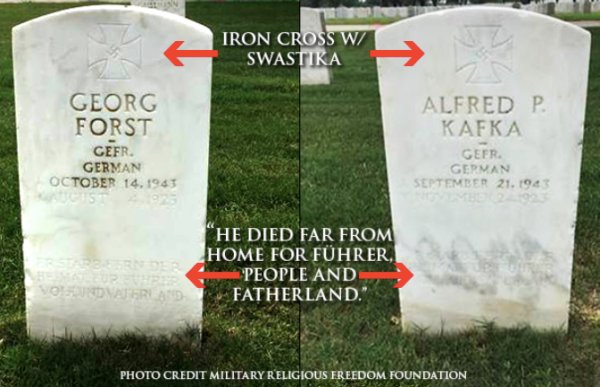

Lawmakers hammered Veterans Affairs Secretary Robert Wilkie on Thursday with questions over whether the department is going to remove a number of gravestones at veteran cemeteries with swastikas on them.
Wilkie’s response? Removing the headstones is somehow akin to pretending the holocaust didn’t happen, and federal regulation makes it very difficult to remove the markers.

The grave markers, three in total, are from the 1940s and belong to German prisoners of war who died while in U.S. custody. In addition to having iron crosses with swastikas on them, two are engraved with a message referencing Adolf Hitler: “He died far from his home for the Führer, people and fatherland.”
The grave sites are located at two veterans cemeteries, Fort Sam Houston National cemetery in Texas, and Fort Douglas Post Cemetery in Utah, which fall under the purview of the VA’s National Cemetery Administration.
Over Memorial Day weekend, Republican and Democratic members of the House called on the department to remove the headstones after the Military Religious Freedom Foundation drew attention to them earlier this month.
The issue revolves around the swastikas, in part, but also stems from having those markers in the same vicinity as gravestones belonging to American soldiers who died fighting the very regime they pay tribute to.
During Thursday’s House Committee on Appropriations hearing, Wilkie addressed the controversy publicly for the first time.
“I have asked my people to look at various ways to address this,” he said. “I happen to think that making sure that when people visit our cemeteries, they are educated and informed of the horror, is an incredibly important thing to do. Erasing these headstones removes them from memory, and as we continue to study the Holocaust, the last thing any Holocaust scholar wants to do is erase that memory, I think we can find a way to put this in historical context. That is my view.”
Wilkie did not guarantee that the VA would remove the headstones, saying instead that it would conduct a review, and look into the possibility of relocating the markers, or providing signage that would offer context on why they are there.
The VA chief added that “we cannot — we cannot erase the horror and ignore it,” before moving on to cite the National Historic Preservation Act of 1966, which he said requires that the VA protect its historic sites, such as cemeteries, and the markers therein.
However, Rep. Debbie Wasserman Schultz, (D-Fla.) immediately pushed back, arguing that Wilkie was misreading the statute, and allowing the department to hide behind federal regulation.
“In fact, what the Historic Preservation Act refers to as historic resources are defined as sites worthy of inclusion on a national register of historic places, and in case you were wondering, the national register of criteria generally does not consider individual grave sites eligible except in case of ‘historical figures of national importance,'” Schultz said. “Certainly German soldiers who took up arms against the United States do not meet this criteria.”
“It appears this is relying on a gross misreading of a law that was enacted to preserve and protect historic sites and neighborhoods, so that we do not erase our nation’s history in the name of development,” she continued. “It is not a blanket excuse to avoid addressing past mistakes.”
